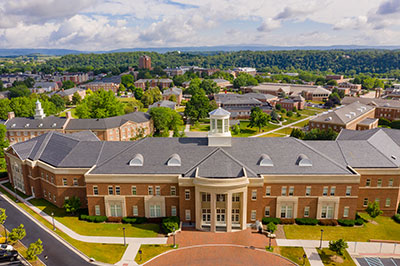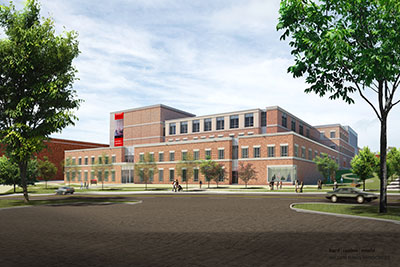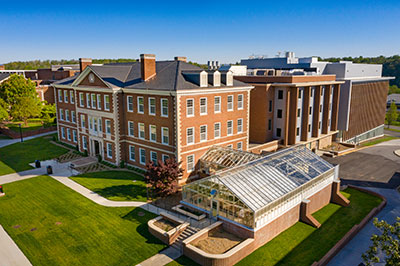A growing legacy
Exiting Radford president bolstered finances, enrollment
A growing legacy
Exiting Radford president bolstered finances, enrollment
Since his selection as president of Radford University five years ago, Brian Hemphill has fulfilled the mission he set when he was hired: to increase fundraising and open channels to boost enrollment.
During Hemphill’s tenure, he has seen the university reach record enrollment numbers and grow its endowment by $20 million. But all things must come to an end — or at least be passed on to a successor.
In February, Hemphill announced that he will be leaving in June to become the ninth president of Old Dominion University in Norfolk. He will succeed John Broderick, who is retiring after 13 years at ODU’s helm.
Hemphill, who through a spokesperson declined to be interviewed for this story, came to Radford with a background of success in fundraising and boosting enrollment in his previous position as president of West Virginia State University (a historically Black university).
“Under [Hemphill’s] leadership, we have … seen a dramatic increase in fundraising that has directly benefited our students,” says Katie Hilden-Clouse, the university’s faculty senate president. “More than $55 million has been raised to directly benefit student aid and scholarships. President Hemphill is a student-focused leader.”
And there are more Radford students than ever — the university grew total enrollment from 9,401 students in fall 2016 to a record 11,870 students in fall 2019. In the wake of the pandemic, fall 2020 enrollment dropped to 10,695 students; it was still the university’s second-highest enrollment year.
Furthermore, Radford boosted enrollment in its online programs tenfold in just a few years, rising from 329 in 2016 to 3,312 in 2020. Hemphill also founded the Vinod Chachra IMPACT Lab, an online training program for K-12 teachers focused on cybersecurity, geospatial intelligence and education.
Meanwhile, the Radford University Foundation’s endowment and investments grew from $54.6 million in 2016 to
$77.7 million in 2021, a 42.3% increase.
Radford also received its largest-ever individual and alum gifts on Hemphill’s watch. In 2017, alumna Nancy E. Artis and her husband, Pat, donated $5 million to name the Artis College of Science and Technology. A year later, Blacksburg couple William and Sandra Davis donated
$8 million to name the Davis College of Business and Economics. (Nancy Artis and Sandra Davis are both former members of the Radford board of visitors.)
Larger footprint
Those are far from the only examples of growth during Hemphill’s presidency. In 2019, he negotiated a merger with the Jefferson College of Health Sciences, a Roanoke-based private health sciences college, and a partnership with Roanoke-based Carilion Clinic to create Radford University Carilion. The merger made Radford’s nursing program the second largest in Virginia and increased Radford’s enrollment by 1,200 students. RUC students learn from practicing clinicians at Carilion Roanoke Community Hospital.
Today, nearly 22% of Radford’s students are pursuing a degree in a health-related field, providing a pipeline for health care professionals in a region of the state that has a shortage of those workers.
The legacy Hemphill leaves behind at Radford is one that may repeat itself at ODU, where the university is seeking a partnership with Norfolk State University to develop a regional School of Public Health. Sentara Healthcare announced in January it has awarded a $4 million grant to the universities to pursue the collaborative school.
“Dr. Hemphill’s successes range from enrollment management to fundraising, and many of his forward-thinking initiatives in such areas as health sciences and partnership-building mirror
Old Dominion’s longstanding strengths and priorities,” says Kay A. Kemper, rector of Old Dominion’s board of visitors. “We believe he will write an exciting new chapter for ODU.”
Hemphill has also expanded Radford’s footprint on and off campus.
“President Hemphill’s tenure has ushered in a new level of achievement and enthusiasm for the Radford family,” says Robert A. Archer, rector of the Radford University board of visitors. “He has certainly created a strong foundation for limitless opportunities well into the future.”
In early 2020 Radford completed the three-year, $34 million renovation of Reed and Curie halls into the Artis College of Science and Technology.
“With science on display, we’re creating a learning environment second to none,” Hemphill said during his December 2020 State of the University address. “A world of discovery has opened for students and faculty as they work side by side and showcase their work.”
Radford will also get a boost from $101 million in state funding toward establishing the Center for Adaptive Innovation and Creativity, which will create a space that will facilitate interdisciplinary work between Artis, the College of Visual and Performing Arts and the Waldron College of Health and Human services. The center will take the place of McGuffey and Porterfield halls. Hemphill has called it a “game-changer.”
Off campus, the university is partnering
with its foundation to build a $20 million
to $25 million boutique hotel, The Highlander, at the intersection of Tyler Avenue and Calhoun Street in Radford. Virginia Beach-based S.B. Ballard Construction Co. and Atlanta-based architects Blur Workshop will build and design the hotel, which is being financed through Texas-based Preston Hollow Capital. Aimbridge Hospitality of Texas will manage the hotel. Ground is expected to be broken on the hotel in May, and it could potentially open in late 2022. No state funds will be involved, the university says. Radford has also announced that it is purchasing $23 million in property near the university for developments including parking lots and off-campus housing.
“His leadership has helped to advance our community in many ways and will continue to reverberate for years to come as the city of Radford and Radford University move forward together,” Radford Mayor David Horton says. “Projects he has championed and shepherded are helping grow the quality of life and robust economic health of this city.”
Erosion prevention
Another important focus for Hemphill has been student retention and maintaining enrollment.
Like many higher education leaders, he has warned of a looming “enrollment cliff” that is expected to make it even harder to recruit an optimum number of undergraduates. That’s because the overall number of college students nationwide is projected to fall more than 15% after 2025 due to a shrinking number of high school graduates and rising tuition costs.
Tricia Easterling, a professor of science education and a board member for the state chapter of the American Association of University Professors (AAUP), hopes Radford will emerge stronger for the challenge.
“We’re down, we’re hurting, we’re about to shrink,” she says. “You know sometimes you expand and sometimes you contract. This is a contracting
point. That just happens with industry change and the circumstances we find ourselves in.”
A massive tuition cut for Radford University Carilion should help. Starting in fall 2020, RUC’s tuition will drop from $21,792 per year to approximately $12,000, bringing it in line with Radford’s regular undergraduate tuition. The cut is being funded via a $10 million allocation from the General Assembly.
In another move to stanch enrollment erosion, the university opened its Academic Success Center in fall 2020 to promote student success and retention, especially among freshmen.
“We’re being more intentional and thoughtful about our work with incoming students,” Hemphill said during his December 2020 address. “Their success is our success.”
The center offers advising services as well as information for students about programs on and off campus. All incoming students are assigned an Academic Success Center adviser, who helps them navigate the college experience.
Bridge to RU, another enrollment initiative started under Hemphill, provides New River Community College students with automatic admission to Radford. As “visiting scholars,” New River students live in Radford campus residence halls, eat in dining halls and study on campus. After their first year of classes
at New River Community College, students also begin taking classes at Radford. Upon earning associate degrees, they are eligible to pursue further education at Radford.

And in 2019, Radford also began participating in the state’s Tech Talent Investment program. The university is expected to receive $17.3 million during
the next 20 years from the state in exchange for producing 400 additional graduates to fill the demand for tech workers statewide and particularly in Northern Virginia, where Amazon.com Inc. is hiring 25,000 workers over the next decade for its HQ2 East Coast headquarters in Arlington.
‘Power grab’
While Hemphill has guided Radford through the uncertainty of the COVID-19 pandemic and leaves the university a larger and wealthier institution, his tenure was not without challenges or controversy. He received criticism from some faculty members following a highly publicized June 2020 action by the Radford board of visitors that removed tenure protections.
Radford faculty members began sounding alarms last summer after the board passed the resolution stating that a reduction in workforce might be necessary due to anticipated budget shortfalls at the school and in the biennial state government budget due to the pandemic.
Citing an urgent need for action, the board granted Hemphill unilateral authority to recommend the elimination of personnel and programs for fiscal years 2021 and 2022 “to ensure the long-term fiscal health of Radford University” and to rid itself of “underperforming activities.”
In doing so, the board also rendered “inapplicable” portions of the Teaching and Research Faculty Handbook, ending job protection for tenured faculty and permitting the discontinuance of programs without following the previously established protocol to consult faculty. That decision created an uproar and drew widespread condemnation from state and national organizations representing college faculty.

“This attitude strikes at the very foundation of true higher education,” says Glen Martin, a philosophy professor and president of the Radford chapter of the AAUP. “It reduces Radford University to a second-rate diploma mill and degrades the significance and role of its faculty.”
“It sort of came across to faculty as a power grab,” adds Easterling.
Even though Hemphill’s relationship with some faculty members may have been strained by the controversy, Radford had not eliminated any staff positions or programs as of mid-March. Because the pandemic’s financial impact was not as bad as expected, the university hasn’t needed to cut jobs or salaries or institute furloughs, according to Ashley Schumaker, Hemphill’s chief of staff and Radford’s vice president for strategic operations. Some budget cuts will likely be announced in April, she adds, but no academic departments or programs will be eliminated, and cuts will be “far less” than the $20 million figure proposed last summer.
“In his five years at Radford University, President Hemphill transformed the university and shepherded it through difficult challenges to make it a stronger, more streamlined institution,” says Sandy Cupp

Davis, namesake of Radford’s Davis College of Business and Economics. “The result is a university whose footprint in the commonwealth has grown dramatically, and whose recognition nationally is outpacing many of the university’s peers.”
Hemphill also leaves Radford with a 10-year master plan through 2030, with a strong focus on growth as well as construction, accessibility and sustainability. After Hemphill departs for ODU, Radford’s provost and vice president for academic affairs, Carolyn Ringer Lepre, will serve as the university’s interim president. A national, comprehensive search for a permanent successor is anticipated to begin in the fall.
Whoever becomes the new president, Caitlyn Scaggs, associate vice president for university relations, says the university is grateful for Hemphill’s leadership: “We feel confident he’s leaving us in a good place.”
University of Radford At A Glance
Founded
Radford University was established as the State Normal and Industrial School for Women at Radford in 1910. Later called the State Teachers College at Radford, it went coed in 1972 and became Radford University in 1979.
Campus
Set against the Blue Ridge Mountains along the New River, Radford’s 204-acre main campus includes three quadrangles and a pedestrian thoroughfare. Many of its structures are built in a red-brick Georgian style. Radford also operates Radford University Carilion in Roanoke and the Southwest Higher Education Center in Abingdon.
Enrollment
Undergraduate: 7,307
Graduate: 3,388
In-State: 8,896 (83%)
Minority: 2,714 (25%)
Faculty
507 full-time
Academic Programs
Radford has 76 undergraduate degree programs in 47 disciplines — including economics, biology, criminal justice and theater — as well as 28 master’s programs and six doctoral programs, including health-related professions.
Tuition and fees
In-state tuition: $11,416
Out-of-state tuition: $23,498
Room & board: $9,720
Average financial aid awarded
to full-time, in-state freshmen:
$11,290
Statistics are based on fall 2020 data
C













